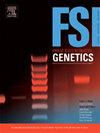EFMex:使用EuroForMix评估多个感兴趣的人的DNA混合物
IF 3.1
2区 医学
Q2 GENETICS & HEREDITY
引用次数: 0
摘要
我们提出了EFMex (euroformix -详尽),这是一个R包,用于计算涉及多个感兴趣的人(poi)的DNA混合物解释中的似然比(LRs)。该软件实现了一个详尽的方法框架,评估poi作为混合贡献者的所有可能子集。我们证明了这个框架的重要性,特别是当贡献者,如近亲,表现出高等位基因共享时。设计了一系列模拟实验,以反映复杂的案例工作场景,使用三人和四人混合进行,其中至少有两个贡献者来自同一家庭。事实证明,即使在具有挑战性的条件下,穷举方法也能有效地区分真正的贡献者和密切相关的非贡献者。对于获得LR>;1的候选人,使用穷举方法重新计算穷举LR,以进一步增加歧视。穷举法的另一种替代方法是使用广义似然比,其返回值与穷举法的返回值非常接近。创建了一个Shiny的应用程序作为图形用户界面,以简化从业者的分析。本文章由计算机程序翻译,如有差异,请以英文原文为准。
EFMex: Using EuroForMix to evaluate DNA mixtures with multiple persons of interest
We present EFMex (EuroForMix–Exhaustive), an R package for calculating likelihood ratios (LRs) in DNA mixture interpretation involving multiple persons of interest (POIs). The software implements an exhaustive method framework, evaluating all possible subsets of POIs as contributors to the mixture. We demonstrate the importance of this framework, particularly when contributors, such as close relatives, exhibit high allele sharing. A series of simulation experiments, designed to reflect complex casework scenarios, were conducted using three- and four-person mixtures in which at least two contributors were in the same family. The exhaustive method proved effective in distinguishing true contributors from closely related non-contributors, even under challenging conditions. A recalculation of exhaustive LR for candidates obtaining LR>1 with the exhaustive method was used to increase discrimination further. An alternative to the exhaustive method, using a generalized likelihood ratio, returned values very close to those of the exhaustive method. A Shiny app was created as a graphical user interface to ease the analysis for practitioners.
求助全文
通过发布文献求助,成功后即可免费获取论文全文。
去求助
来源期刊
CiteScore
7.50
自引率
32.30%
发文量
132
审稿时长
11.3 weeks
期刊介绍:
Forensic Science International: Genetics is the premier journal in the field of Forensic Genetics. This branch of Forensic Science can be defined as the application of genetics to human and non-human material (in the sense of a science with the purpose of studying inherited characteristics for the analysis of inter- and intra-specific variations in populations) for the resolution of legal conflicts.
The scope of the journal includes:
Forensic applications of human polymorphism.
Testing of paternity and other family relationships, immigration cases, typing of biological stains and tissues from criminal casework, identification of human remains by DNA testing methodologies.
Description of human polymorphisms of forensic interest, with special interest in DNA polymorphisms.
Autosomal DNA polymorphisms, mini- and microsatellites (or short tandem repeats, STRs), single nucleotide polymorphisms (SNPs), X and Y chromosome polymorphisms, mtDNA polymorphisms, and any other type of DNA variation with potential forensic applications.
Non-human DNA polymorphisms for crime scene investigation.
Population genetics of human polymorphisms of forensic interest.
Population data, especially from DNA polymorphisms of interest for the solution of forensic problems.
DNA typing methodologies and strategies.
Biostatistical methods in forensic genetics.
Evaluation of DNA evidence in forensic problems (such as paternity or immigration cases, criminal casework, identification), classical and new statistical approaches.
Standards in forensic genetics.
Recommendations of regulatory bodies concerning methods, markers, interpretation or strategies or proposals for procedural or technical standards.
Quality control.
Quality control and quality assurance strategies, proficiency testing for DNA typing methodologies.
Criminal DNA databases.
Technical, legal and statistical issues.
General ethical and legal issues related to forensic genetics.

 求助内容:
求助内容: 应助结果提醒方式:
应助结果提醒方式:


